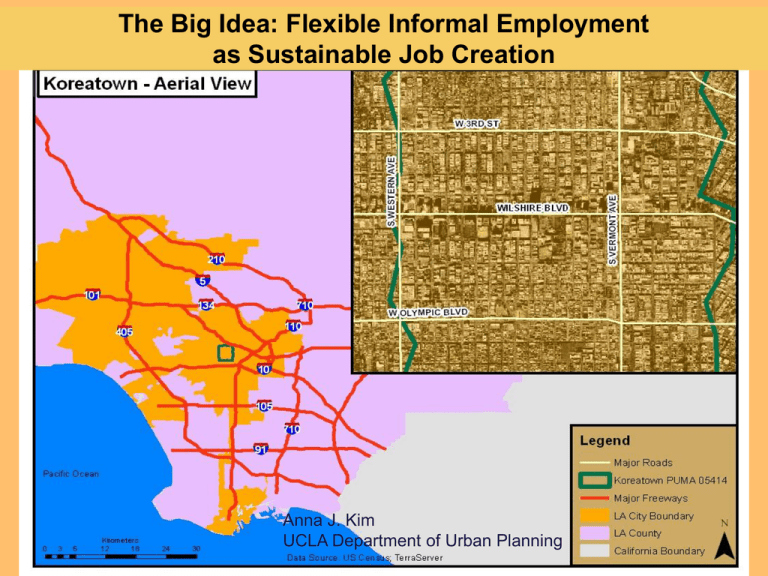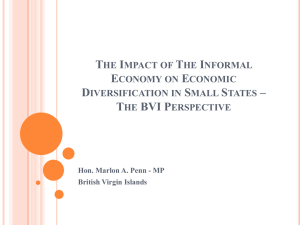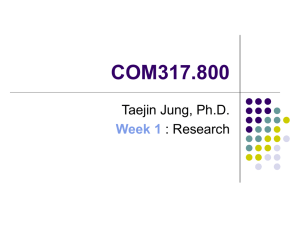
The Big Idea: Flexible Informal Employment
as Sustainable Job Creation
Anna J. Kim
UCLA Department of Urban Planning
How can informal employment
be measured at the local scale?
Proxy indicators in secondary data:
Census SF-1, SF-3; ACS PUMS 2000; 2006-2008
How can informal employment
be counted as job creation?
Interviews with individuals who have participated in the informal
sector, restricted by geography and target group.
Quantitative Proxy Measures
Measuring Informality at the Local Scale
1
Social Compact Model:
Check-cashers, Foreign-born population demographics, Cash utility payments
2
Labor Force Participation:
Employment Status (ESR) vs. Working/Not-working
3
Employer-Reported Employment:
Payroll vs. Self-reported
4
Employment Sector:
Undocumented Workforce as predictor of size of informal labor market
Data Set: Census PUMS (2000, 2006-2008)
Data Set: CA EDD ES-202 (2000, 2006-2008)
Data Set: Current Pop. Survey (2000, 2006-2008)
How are we counting informal
jobs?
By Proxy:
1.Check-cashing businesses and their locations in certain
neighborhoods
The Social Compact model, based on case studies of four
neighborhoods in Chicago, proposes eight proxies as predictors of
informal employment. These include: Percentage of households with no
banking relationships or credit histories; Percentage of utility payments
made in cash; Prevalence of check-casher operations per acre;
Prevalence of check-casher operations per household. (Alderslade,
Talmadge, and Freeman, 2006).
The example of ACE Cash
Express reveals that they
cluster check-cashing
locations in areas of high
poverty – but does this
mean that the money that
changes hands is earned
informally?
In this example, results seem inconclusive as a
predictor of informal economic activity.
Data Source: Geocode of 34 store locations from Acecashexpress.com
So who does Check-Cashing target?
How are we counting informal
jobs?
By Proxy:
2. By residential density of highly immigrant neighborhoods
Marcelli, Pastor and Joassart (1999) propose a computation for
calculating the number of “unauthorized” immigrants, and by extension,
unauthorized immigrant workers in the Latino population using four
main characteristics (years since immigration, years of formal
education, age, and sex) as a predictor of legal status at an accuracy of
about 85%.
Why is Koreatown important?
Source: US Census, LED on the Map. 2008 QCEW
Koreatown: Population Graphs
The residential population of Koreatown is predominantly foreign-born.
Composed primarily of Korean, Mexican, Salvadorian, and Guatemalan ethnic groups,
in order of size. All groups are mostly Non-English speaking.
Data Set: Census PUMS (2000)
How are we counting informal
jobs?
By Proxy:
3. Discrepancies in Reported Employment
Flaming and Burns (2006) also estimated informal employment by
checking for anomalies between reported employment by workers
versus reported employment by employers. The report estimated that
approximately one third of workers in the Koreatown area work in
informal jobs, and that this “rate of informal employment is twice as
high as the rate found in the City of LA”.
Central City PUMAs: A Comparative Analysis
PUMA
Neighborhood
05414 Koreatown
05412 West Los Angeles
North Los Angeles
05413 (includes Hollywood)
Eastern Los Angeles
05415 (includes Downtown)
05418 South Los Angeles
05703 Long Beach
Immigrant Neighborhoods Look
Different & Work Different
As a Comparison PUMA,
Long Beach PUMA
05703 is markedly
different, not just from
Koreatown but Los
Angeles in general
LA County
Long Beach
Koreatown
Population
10,000,000
130,000
115,000
Mean Wage
$25,000
$34,000
$15,000
ACS Census PUMS 2006-2008
Testing Proxy indicators for informal employment (ACS PUMS 2000)
PUMA
NEIGHBORHOOD
HHLD REPORTED EMPLOYMENT ERROR
05414
Koreatown
10.2%
05412
West Los Angeles
3.1%
05413
North Los Angeles
(includes Hollywood)
2.1%
05415
Eastern Los Angeles
(includes Downtown)
8.5%
05418
South Los Angeles
6.6%
05703
Long Beach
(CSULB area)
0.59%
What Immigrant Workers Have to
Say About Informal Jobs…
Interviews: Sonia
“The main difference in the formal and informal is that if I make $400
informally [a week] I get 400 to take home for me. If I make $400 in
check, then maybe I take home like $375 for real. Out of that $25
goes into paying taxes and I don’t ever see that again. And yet there
are no benefits for me that I can use.”
“We have to support the system, we pay the taxes. It’s what’s right.
You know they always say that the undocumented are taking
advantage of the Medicare or CalWorks and everything, and that
someone else has to support us. But that’s an offense to us because
at the end we are the ones giving, we pay and we don’t get anything
back.”
Interviews: Gloria & John
“Well if we generalize the undocumented
folks yes because of the documentation
you need it [formal work] is harder. But to
my luck I haven’t had a hard time
because of my experience. I have my
own ability and flexibility and dedication
to the work I have.”
“I get paid in cash at my work. The
bosses, a lot of times they don’t ask to
see papers and I know because I check
the ad when it is outside. If it just says
looking for someone to work and doesn’t
mention anything else, no requirements,
I know what that means.”
Flexible, Quasi-Formal,
Transitional Employment
“A long time ago in Koreatown it was always cash. Maybe there were some
who paid people formally but definitely I used to always get paid in cash,
then slowly I noticed they would change it to like a little bit more of check at
a time and then tell me that I’m a “part-time” worker
… and then sometimes there would be inspections from the labor
department at my work because maybe they thought there was something
funny going on. And then the owner would adjust again for a little while and
give me more checks, and then reduce it again and give me cash. There
was a lot of incidences like that.”
… is that they are not very different
from formal jobs.
Why Do Firms Hire Informally?
Flaming and Burns (2006) found that “small businesses are more likely
to hire informally and compensate workers informally,” and that within
the Koreatown area there were higher rates of both self-employment
and small businesses (under 50 employees) than the city of Los
Angeles as a whole.
For a full-time, minimum wage employee in California, an employer pays:
Employer Advantages to Informal / Semi-Formal Job Creation
What could informal job creation
look like, as a policy or program?
1. Lower the risk of participation for undocumented persons
(employees and/or employers) who participate in informal
work “registration program”.
1. Business owners would be exempt from payroll taxes for new
informal employees (as they already are); and workers will
also be exempt from payroll taxes during the informal period
1. A third party agency like non-governmental organizations like
workers centers, workers advocacy groups, workforce
development agencies should maintain the database of
participating firms and employees.
It’s already, almost, being done…
The Big Idea: Flexible Informal Employment
as Sustainable Job Creation
1.
Being able to “count” a hitherto uncounted informal job
raises employment rates and lowers unemployment rates by
adding to the count of jobs and employed persons that
currently exist and lack exact measurement mechanisms.
1.
In the absolute, facilitating informal employment and
lowering the costs of employment creates more
opportunities for work in both the short-term and long-term.








